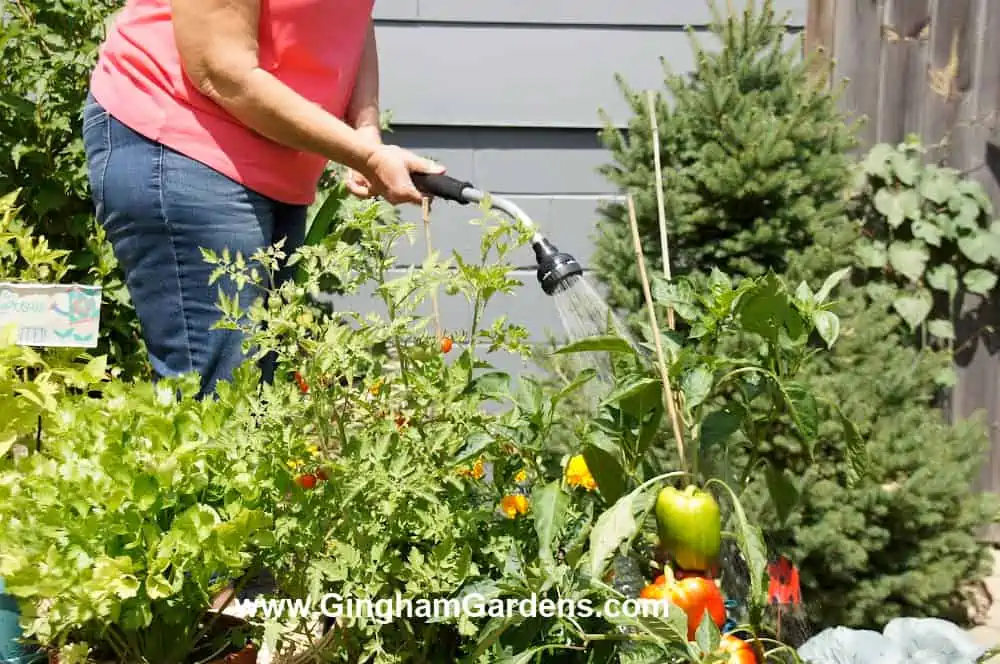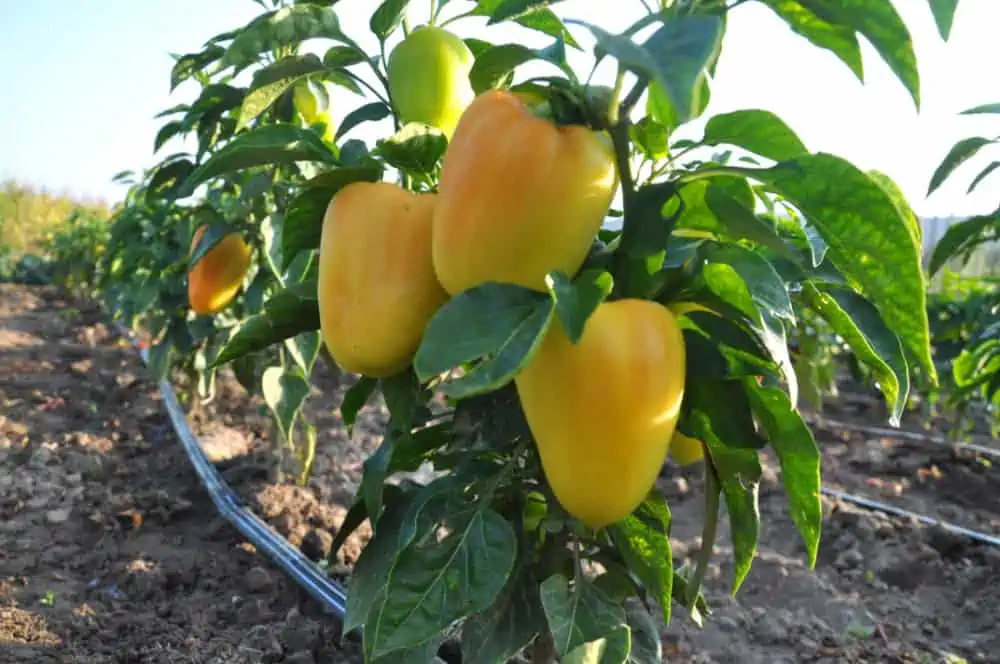How to Efficiently Water Your Garden
Developing good, consistent watering habits can determine the success of your vegetable and flower gardens. All the how’s, why’s, what’s and when’s can be very confusing and leave gardeners (both new and experienced) wondering if they are doing it correctly. Unfortunately, infrequent watering and long dry spells can wreak havoc on your gardens and be the forerunner of many plant diseases. Regular watering is always the best practice. At the same time, with dry summers becoming a norm in many areas, we need to be responsible with our water consumption. As always, we will try and keep it simple, yet thoroughly answer all your questions about how to efficiently water your garden.
When is the Best Time of Day to Water Your Garden
This is an age old question – is it better to water in the morning, afternoon or evening? Everyone has their preference, but really the best time is when you can water! Although watering in the early morning is generally best, what if it’s not convenient for your schedule. What if you are trying to get kids out the door and you have to get to work yourself. You don’t need the added stress of watering your garden.
What about watering during the heat of the day? Does watering in the bright sun, cause burn marks on your plants? Absolutely not! That is a myth and you will see it a lot if you’re on any gardening forums or Facebook gardening groups.
Watering during hot weather in the middle of the day can actually cool down plant temperatures and keep the plants from losing moisture. Is watering during the hottest part of the day the most effective way to water? No it is not, because much of the water will evaporate before it reaches the roots of your plants.
It is true that watering in the late evening can cause more fungal diseases in plants because the wet leaves don’t have time to dry.
So, again, the best time to efficiently water your garden is in the early morning. The next best time is late afternoon or early evening. But, watering when you can is better than not watering at all.
This post contains affiliate links. If you click on
one of the links and make a purchase,
I may receive a small commission at no additional cost to you.
See full disclosure here.
What is Your Soil Type?
What does soil type have to do with watering your gardens efficiently? I won’t go into a big, old science lesson here, because we’re keeping it simple. How much water your garden needs depends on the soil type. If you have sandy soil, it drains rather quickly and will need more frequent watering. In my gardens, the soil is sandy and I need to water more frequently. If you have clay soil, your soil retains moisture and will require less water.
You can tell what type of soil you have by it’s texture. Not sure if you have sandy or clay soil, here’s a quick test: simply gather up a handful of soil and squish it into a ball. If the soil holds together you likely have clay soil. If it falls apart, you have sandy soil. The perfect soil is a combination of both called loam.
How Much Water Does My Garden Need?
The best way to tell if your garden needs water is to simply dig down several inches in a few places and see if the soil feels dry. If it does, then it’s time to water. You can also use a handy moisture meter. If you decide to use a moisture meter, it’s a good idea to double check it’s accuracy by digging down in your garden and checking the soil moisture.
So, how does one tell how much water is the right amount of water? Flower and vegetable gardens generally need around 1 inch to 2 inches of water per week. Perennial gardens with established plants do okay with a little less. Keep in mind that new plants, as well as young plants and seedlings will require more water to get established. Gently water newly seeded areas and small plants, so you don’t wash away the soil around them.
How can you tell what 1 inch of water is in your gardens. A good way is by using a simple rain gauge in various places in your gardens. Rain gauges are good at measuring overhead moisture like rain and water from overhead sprinklers. I like this large rain gauge for my vegetable garden and decorative rain gauges for my flower gardens.
It is important to note that too much water can also be detrimental to your garden. Although we can’t control how much rain our gardens get, we want to make sure we don’t overwater.
Many years in spring we have sufficient water and I don’t have to worry about watering my gardens at all, but as summer heat kicks in that becomes a different story.
Different Ways to Efficiently Water Your Garden
Rain water is always the best, but Mother Nature doesn’t always cooperate, so gardeners have to come up with other ways to be sure our gardens are getting an efficient amount of water.
Hand Watering
I love to hand water my gardens, but I have to be realistic in that everyone does not have time to hand water their gardens. If you do hand water, use a long watering wand and water at the base of the plant. Watering at the base of your plants is the best way to water because the water is going straight to the roots. Set your nozzle on the soaker or flood setting and dial back the pressure. Then hold the wand so that the nozzle is at the base of your plant and hold it there until the water starts to pool.
It is also important to say that one good soak, or slow deep watering is much better than 3 quick shallow watering sessions. If water is being soaked up deep into the plant root zone, the roots of the plant will grow deep, reaching for moisture. Quick watering isn’t good, because it only covers the soil surface and can create shallow root systems that dry out quickly.
Overhead Sprinklers
Watering from overhead sprinklers is okay if that’s the best you can do, but it is not the most efficient way to water a garden. When watering overhead, much of the water is lost from evaporation, or landing on pathways or sidewalks where the water isn’t needed.
Drip Irrigation or Soaker Hoses
Installing a simple drip irrigation system or using soaker hoses is the most efficient way to water your garden. The water from a drip system or soaker hose is directly on the ground or close to it, so that the water is right where it needs to be. It can take some time to initially set up drip systems or soaker hoses in the spring, but the effort is so worth it when the heat of summer sets in. Irrigation systems and soaker hoses are the best ways to lessen water use in your gardens.
Effectively Watering Container Plants and Raised Garden Beds
It is important to note, that container gardens and raised garden beds dry out much more quickly than inground gardens. It is a good idea to closely monitor them especially during hot dry weather. Sometimes they will need to be watered more than once per day.
Use the free, printable Gardening Calendar in the Gingham Gardens Resources Library to keep track of all your gardening chores, including watering. Get immediate access by completing the form below.
The Perfect Remedy to your Garden Watering Woes
I realize that not everyone has the time or ability to keep up with watering your gardens. In these cases, I strongly suggest looking into purchasing some of these items to lighten the burden of making sure your garden is watered efficiently. With all the other chores that go along with maintaining a garden, it’s always nice to have a way to simplify these tasks. Plus, if you have a large garden or many gardens, utilizing these gadgets can be a huge timesaver.
Do you hate lugging hoses around? I get so tired of dragging hoses around my big yard and then trying to wind them up. I finally decided I needed a retractable hose and OH MY why did I wait so long. This thing is amazing and I would have saved aggravation and money over the years if I would have purchased one of these a long time ago.
My next favorite hose is this steel hose. It’s super light weight and best part, it doesn’t kink! I read a lot of reviews about this hose before I purchased it.
Between utilizing soaker hoses and drip systems, plus the addition of a timer installed on your outdoor water faucet, you can reduce the time spent watering your gardens significantly.
Having a timer system set up, is also a wonderful way to not have to worry about your gardens while you’re on vacation. I do recommend having a neighbor or family member check every day or two, just to make sure your timer hasn’t malfunctioned. It would be awful to return from vacation to a flood and a crazy high water bill.
A Few More Tips for Conserving Water in Your Gardens
Rain barrels (also know as water butts) collect and store water from a home’s gutters, basically providing free water to gardeners. Getting the water from the rain barrels to the garden can be done in a variety of ways, with hoses, watering cans, or irrigation systems. I don’t recommend watering vegetable gardens with rain water collected from rain barrels because of the sediment and chemicals coming off roof shingles, but it’s wonderful for watering flower gardens and container gardens. There are many tutorials on installing a rain barrel on YouTube.
Another way to conserve water and to keep as much moisture in your soil as possible is by using organic matter, such as mulch. I prefer a fine shredded wood mulch, but shredded leaves and untreated grass clippings are also very good organic materials to use to help retain soil moisture. For vegetable gardens, I prefer using dried grass clippings and shredded leaves. For my flower gardens, I use shredded wood mulch. Learn more about adding mulch to your gardens in this helpful post.
When considering your garden watering schedule for the week, always check the weather forecast. Rain water is free, but your water bill is not.
Are you in an area where you need to consider gardening with drought resistant plants? That’s called xeriscape and you can learn more about it in this really interesting article – Xeriscape Gardening: Growing Plants with Less Water.
More great gardening tips from Gingham Gardens:
- How to Deal With Weeds in Your Garden
- Dealing with Garden Pests
- Flower Gardening 101
- Growing Vegetables in Pots
I hope you picked up some new tips or ideas for watering your garden more efficiently and are on your way to a successful gardening season. Do you have another watering tip I missed. If so, I love to hear about it. Please leave your comment or question below.
Happy gardening,
Joanna
p.s. Feel free to save the pins below to your favorite gardening board on Pinterest. If you hover in the upper left-hand corner of the picture, you’ll see the little Pinterest icon. Just click it and pin away. There are more pins to share below.
p.p.s I’d love to have you follow Gingham Gardens on Pinterest. Lots of great gardening ideas and tons of eye candy for gardeners. Gingham Gardens is also on Facebook.
Save a pin to your favorite gardening board:





